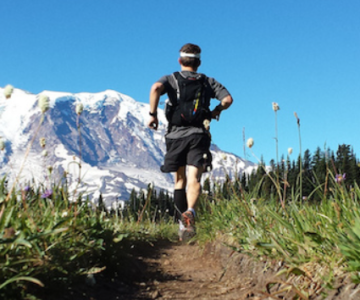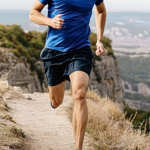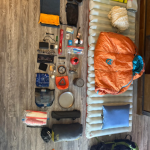Preparing for a backpacking trip can be overwhelming if you’re not sure what to bring. The key to a successful hike is striking the right balance between packing too much and packing too little. Bringing unnecessary items can weigh you down, while forgetting essentials can leave you unprepared for unexpected situations. In this guide, we’ll walk you through what to pack for an overnight hike, based on factors like weather, trail conditions, and the length of your trip.
What to Pack: Key Gear for Your Backpacking Trip
Packing for a backpacking trip is all about efficiency. Here’s a breakdown of what you’ll need, divided into essential, optional, and shared categories.
General Gear
- Backpack (Shared): Your backpack should fit comfortably and have enough capacity for your essentials. A 50-60 liter pack is typically a good choice for most overnight trips.
- Headlamp: A reliable headlamp is essential for navigating after dark. Make sure it has a strong beam (300+ lumens) and weatherproofing (IPX4).
- Water Filtration System: A good water filter or purifier will ensure you can safely drink from natural sources. Consider a compact filter like the Sawyer Mini.
- Pack Rain Cover: If there’s any chance of rain, protect your gear with a rain cover. Many packs come with one built-in, but if not, it’s a smart addition.
- Multitool or Knife: A small knife is essential for cutting tasks. A multitool can be helpful but is often more bulky than necessary.
- First Aid Kit: Always carry a basic first aid kit with essentials like bandages, antiseptic wipes, and blister treatment.
- Trekking Poles (Optional): Poles can be helpful for stability, especially on steep terrain or when crossing streams.
Sleep Setup
- Sleeping Bag or Quilt: Choose between a sleeping bag or a quilt, based on your preference for warmth and weight. Down fill is lightweight and compresses well, while synthetic options are more affordable and handle moisture better.
- Sleeping Pad: A good sleeping pad provides comfort and insulation. Closed-cell foam pads are durable and light, while air pads offer better comfort but can puncture.
- Tent or Tarp (Shared): If you’re expecting poor weather or need extra protection from bugs, a lightweight tent is your best bet. Otherwise, a tarp can save weight and pack space.
Camp Kitchen
- Stove: A lightweight stove like the MSR Pocket Rocket is great for boiling water quickly. If you’re cooking meals, ensure you have a stove that allows for temperature control.
- Cookware: A small pot (1L) should be sufficient for cooking meals for two. Titanium is light but expensive, while aluminum is affordable and good at heat distribution.
- Utensils: Bring a spork or a lightweight utensil set to keep your pack light and compact.
- Food Provisions: Bring calorie-dense foods such as freeze-dried meals, nuts, and energy bars. Don’t forget snacks to keep your energy up throughout the day.
Footwear & Headgear
- Boots or Shoes: Trail shoes are lightweight and provide adequate support for most backpackers. Boots can be helpful on rougher terrain, but they’re heavier.
- Hat: A wide-brimmed hat protects your face and neck from the sun, while a bandana or Buff can help manage sweat.
- Sunglasses (Optional): A good pair of sunglasses will protect your eyes from UV rays, especially on sunny trails.
Hiking Clothes
- Hiking Shirt: Look for a moisture-wicking shirt made of synthetic fabric or merino wool. Long-sleeve shirts can provide added sun protection.
- Hiking Pants or Leggings: Choose pants that are lightweight, breathable, and quick-drying. Convertible pants are great for changing conditions.
- Socks: Invest in moisture-wicking, breathable socks that will keep your feet dry and prevent blisters. Merino wool blends work well for most conditions.
- Underwear: Choose moisture-wicking underwear to stay comfortable, especially on multi-day hikes.
Packed Clothes
- Fleece Midlayer: Fleece is breathable, moisture-wicking, and provides good warmth when damp. A fleece pullover is versatile and lightweight.
- Puffy Jacket: A down or synthetic fill jacket provides warmth without adding bulk, and it’s perfect for cold nights.
- Rain Gear: A rain jacket or poncho will keep you dry during wet weather. For added protection, waterproof pants are a must if you expect heavy rain.
- Camp Clothes: Pack an extra set of clothes for when you’re relaxing at camp. This should include warm, dry layers to protect against cold evenings.
Key Factors to Consider When Packing
Weather & Trail Conditions: The weather will be a major factor in deciding what gear to bring. In wet or cold conditions, extra insulation and rain gear will be necessary. Make sure to pack layers to stay comfortable.
Water Sources: Knowing where you’ll find water is crucial. A water reservoir, bottles, and a filter will help you stay hydrated, especially on long hikes where water sources are scarce.
Time on Trail: Longer hikes require more planning for food, fuel, and batteries. If your route doesn’t pass through towns, you may need to cache supplies or resupply on the trail.
Remoteness: In more remote areas, where cell service may be unavailable, a GPS, map, and compass are essential. Be prepared for emergencies by bringing a survival kit and a satellite messenger if needed.
Wildlife: In areas with wildlife, carry supplies to protect your food and yourself. Knowing how to safely interact with animals is key.
Additional Considerations
Multitool or Knife: A multitool can serve many purposes, but a good-quality knife is often all you need. It’s compact and functional for a variety of tasks.
Power Bank: If you plan on using electronic devices like GPS or a satellite messenger, a portable power bank will keep your devices charged.
Trowel: If you need to dig a cat hole, a small trowel is much more efficient than a stick or tent peg.
Getting Started: Experience Is Key
The best way to determine what works for you is to head out on the trail. With each hike, you’ll learn what gear is essential and how to refine your packing strategy. Keep experimenting and fine-tuning your kit, and soon you’ll have the perfect setup for your backpacking adventures.





